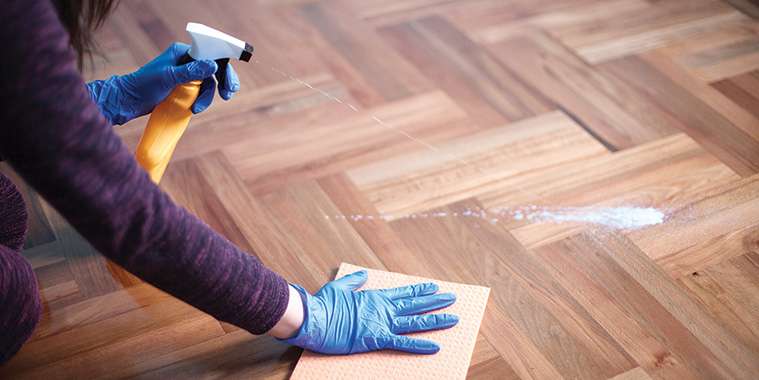For many homeowners, keeping hardwood floors blemish-free can feel like a full-time job. When
wine spills, permanent marker streaks, or other household disasters happen (and they will happen), knowing how to remove stains from hardwood floors is crucial.
Time is of the essence when it comes to getting rid of stains. “Clean them up right away,” says Brett Miller, vice president of education and certification for the National Wood Flooring Association. “Then they won’t penetrate into the wood, when it’s most damaging.”
When simple spills happen, the first step how to remove stains from hardwood floors is wipe them up with a cloth dampened with water.
For tougher stains and marks that have sat for a while, you might have to eventually remove the stained boards, add new ones, and refinish the entire floor so old and new blend together — although that’s the worst-case scenario.
Before you call in the hardwood cavalry, be sure to try these time-tested stain solutions:
• Water
If you’ve just spilled some water, use a hair dryer on high setting to dry the area for about 15 minutes, or until any trace of the water is gone. If that doesn’t work, apply an oily substance such as petroleum jelly or mayonnaise (yes, mayonnaise) to the affected area and let it sit overnight. Wipe away the solution with a clean cotton cloth. The oil will restore some of the transparency (by filling some of the microscopic voids) of the stain, according to popularwoodworking.com.
• Scuff marks
Technically scuff marks from furniture feet or sneakers are not actually stains, but they are a beast to remove. If wiping with a damp microfiber cloth doesn’t work, try erasing marks with a pencil eraser or a clean tennis ball, which uses slight friction to remove the stain. If there’s an actual scratch in the wood, cut or bite an almond in half and rub the meat part on the scratch. The oil from the almond should fill it in.
• Pet urine
In the life of every pet, accidents happen. The trick is to sop up the mess before it soaks into the floor, and to treat the floor with one of the many “enzymatic” commercial sprays you can buy at pet supply stores. The enzymes will attach to and break down molecules that create odors.
Cat urine, which has a higher ammonia concentration than the
canine variety, is particularly hard to get rid of, even with enzyme sprays.
“That smell will linger if it’s not addressed,” Miller says.
And if it soaks through the floor into the subflooring, well, you’re sunk. In that case, you’ll have to hire a company to remove the tainted floor and subflooring boards. This is probably not a DIY job, because blending old and new wood planks is an involved process, so you’ll want to consult a flooring professional.
• Permanent marker
Don’t panic! You can remove errant Sharpie marks on hardwood floors with 90% isopropyl alcohol.
Pour the alcohol on a clean cloth and apply to the stain. Rub gently until the stain transfers from floor to cloth. To prevent a haze from forming, rinse the area with water and dry. If a haze does form, put a dab of olive oil on a cloth and rub; it should look as good as new.
If the alcohol method doesn’t work, put a dab of white (not gel) toothpaste on a clean cloth and rub out the stain. When the Sharpie mark disappears, wipe the spot with a damp cloth to remove the paste.
• Assorted stains on dark hardwood
Olivia Joyce, who is a representative of the UK branch of the Australian cleaning company Move Out Mates, uses a black tea solution to remove food and grease stains from medium-to-dark wood floors.
Steep five or six black tea bags in about a quart of water. When the tea cools, dampen a microfiber cloth with the tea and place on the stain for a minute,
then wipe with a paper towel. Repeat until the stain disappears.
“The tannic acid in the black tea gently removes stains off the surface without damaging it,” Joyce says, “something chemical detergents wouldn’t be able to do.”
— realtor.com



